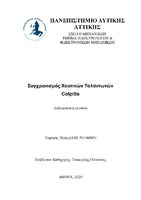| dc.contributor.advisor | Τσακιρίδης, Οδυσσέας | |
| dc.contributor.author | Τομαράς, Ηλίας | |
| dc.date.accessioned | 2021-03-09T11:49:27Z | |
| dc.date.available | 2021-03-09T11:49:27Z | |
| dc.date.issued | 2020-09-03 | |
| dc.identifier.uri | https://polynoe.lib.uniwa.gr/xmlui/handle/11400/318 | |
| dc.identifier.uri | http://dx.doi.org/10.26265/polynoe-169 | |
| dc.description.abstract | Φιλοδοξία της παρούσας Διπλωματικής εργασίας είναι η ανάπτυξη ενός συστήματος μέσω του οποίου επιτυγχάνεται ο συγχρονισμός ανάμεσα σε έναν ιδεατό και έναν πραγματικό ταλαντωτή Colpitts. Το εν λόγω σύστημα, για τον συγχρονισμό
των δύο ταλαντωτών, παρουσιάζει ένα ιδιαίτερο χαρακτηριστικό, καθώς οι δύο ταλαντωτές έχουν υλοποιηθεί με διαφορετικό τρόπο. Ο πρώτος ταλαντωτής έχει υλοποιηθεί μέσω software ενώ αντίθετα ο δεύτερος ταλαντωτής έχει υλοποιηθεί μέσω
hardware. Στην παρούσα Διπλωματική εργασία περιγράφεται η θεωρία, καθώς και η ιστορική εξέλιξη του χάους και αναλύονται ορισμένες ιδιότητες που πρέπει να διέπουν τα δυναμικά συστήματα ώστε να θεωρηθούν χαοτικά. Επιπλέον παρουσιάζονται
ορισμένα από τα πιο διάσημα μοντέλα που εμφανίζουν χαοτική συμπεριφορά. Το επίκεντρο του ενδιαφέροντος όμως βρίσκεται στον ταλαντωτή Colpitts, για τον οποίο πραγματοποιείται αναλυτική παρουσίαση τόσο της χαοτικής λειτουργίας που εμφανίζει
με την επιλογή συγκεκριμένων παραμέτρων του κυκλώματός του, όσο και του συγχρονισμού ανάμεσα σε δύο χαοτικούς ταλαντωτές Colpitts. Τέλος παρουσιάζονται όλες οι προσομοιώσεις και τα πειραματικά αποτελέσματα που πραγματοποιηθήκαν για
την επίτευξη του στόχου της εργασίας. Η συγκεκριμένη προσπάθεια επίτευξης συγχρονισμού των χαοτικών ταλαντωτών
Colpitts δεν οδήγησε τελικά στον συγχρονισμό, ο οποίος ήταν και ο στόχος της συγκεκριμένης Διπλωματικής εργασίας. Επομένως παρατίθενται ορισμένες αιτίες που πιθανόν να οδήγησαν στην μη επίτευξη συγχρονισμού και επιπλέον αναφέρονται
ορισμένες λύσεις όπως η δημιουργία ενός πιο σύνθετου μοντέλου που πιθανόν θα οδηγήσει στον συγχρονισμό των δύο ταλαντωτών Colpitts. | el |
| dc.format.extent | 123 | el |
| dc.language.iso | el | el |
| dc.publisher | Πανεπιστήμιο Δυτικής Αττικής | el |
| dc.rights | Αναφορά Δημιουργού - Μη Εμπορική Χρήση - Παρόμοια Διανομή 4.0 Διεθνές | * |
| dc.rights | Attribution-NonCommercial-NoDerivatives 4.0 Διεθνές | * |
| dc.rights.uri | http://creativecommons.org/licenses/by-nc-nd/4.0/ | * |
| dc.subject | Ταλαντωτής colpitts | el |
| dc.subject | Colpitts | el |
| dc.subject | Χάος | el |
| dc.subject | Χαοτικός ελκυστής | el |
| dc.subject | Συγχρονισμός ταλαντωτών colpitts | el |
| dc.subject | Ελκυστής colpitts | el |
| dc.subject | Χαοτική συμπεριφορά | el |
| dc.title | Συγχρονισμός χαοτικών ταλαντωτών colpitts | el |
| dc.title.alternative | Synchronization of chaotic colpitts oscillators | el |
| dc.type | Διπλωματική εργασία | el |
| dc.contributor.committee | Ζώης, Ηλίας | |
| dc.contributor.committee | Alexandridis, Alex | |
| dc.contributor.faculty | Σχολή Μηχανικών | el |
| dc.contributor.department | Τμήμα Ηλεκτρολόγων και Ηλεκτρονικών Μηχανικών | el |
| dc.description.abstracttranslated | The aspiration of this thesis is the development of a system through which synchronization between an ideal and a pragmatic Colpitts oscillator is achieved. This respective system displays a unique characteristic in reference to the synchronization
of the two oscillators, as they have been implemented differently. The first oscillator has been developed via software, while the second oscillator has been developed via hardware. This study describes the theory, along with the history of the concept of chaos. Also certain qualities that have to govern dynamic systems in order for them to be considered chaotic are thoroughly analyzed. Additionally, they are presented some of the most famous models which exhibit chaotic behavior. The focus, however, is on the Colpitts oscillator, for which a detailed presentation is introduced of both the chaotic function it displays through the selection of specific parameters of its circuit and also the synchronization between two chaotic Colpitts oscillators. Finally, all the
experimental results and simulations that have been carried out to achieve the objective of the work are presented. The current effort to achieve synchronization between chaotic Colpitts oscillators did not lead to the desirable result, which was the synchronization of the chaotic oscillators. Therefore, there are a number of possible reasons that may have led to the
failure of the desirable synchronization. In addition, some solutions are mentioned, such as the implementation of a more complex model that may possibly lead to the synchronization of the two Colpitts oscillators. | el |


